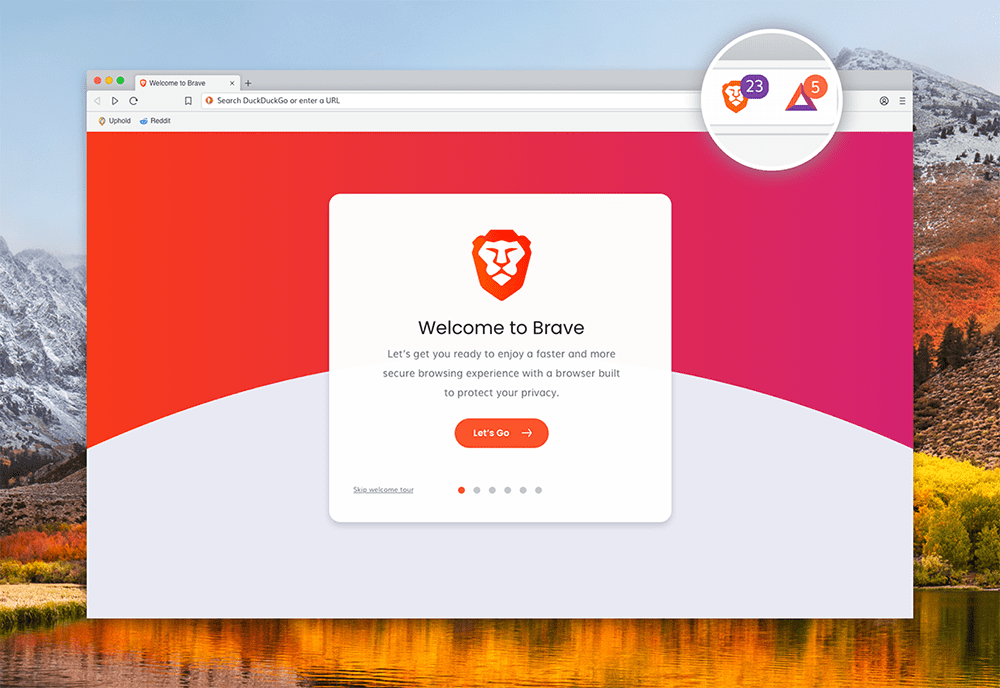Last updated on July 31st, 2025 at 12:56 pm
Traditional web browsers, such as Google Chrome and Apple Safari, have become the default tools for navigating the internet. They offer speed, seamless integration, and convenience, but often at a hidden cost: your personal data. These browsers track user behaviour extensively, building detailed profiles to fuel targeted advertising and corporate profits. As awareness about digital privacy grows, more users are beginning to question whether the trade-off between convenience and control is worth it.
That’s where Brave browser steps in. Designed to disrupt the current browser space by blocking trackers, safeguarding user data, and even rewarding users with cryptocurrency for viewing ads they choose to see. Brave browser isn’t just promising a faster, safer browsing experience, it promises a new model where users, not corporations, have control.
This review explores how Brave browser challenges the traditional browser giants, redefines the balance between privacy and convenience, and asks: Can Brave browser truly change the way we browse the web? Let’s find out.
Brave Browser: The Privacy-First, Blockchain-Powered Contender
Imagine using the internet without being constantly watched, tracked, or fed creepy ads based on stuff you said out loud five minutes ago. That’s what Brave browser is trying to fix.
Brave isn’t just another blockchain browser, it’s a whole new way to experience the web. It’s faster, safer, and actually pays you for your attention instead of selling your data behind your back.

Let’s break down why it’s such a game-changer.
No Ads, No Trackers, Just the Stuff You Care About
The first thing you’ll notice when using Brave browser? No annoying ads. Brave browser blocks all those intrusive banners, pop-ups, and trackers the second you open it. This isn’t a plugin you need to install, it’s just how Brave’s privacy-focused browser works by default.
This means:
- Your personal data doesn’t get harvested.
- You’re not stalked around the web by ad companies.
- Websites load without all the extra baggage slowing them down.
In other words, you get a cleaner, more peaceful internet.
It’s Crazy Fast (Like 3–6x Faster Than Chrome)
Without the junk that slows down most websites, like ads, tracking scripts, and autoplay videos, Brave browser runs super smoothly. Pages load instantly, and your device doesn’t heat up like it’s about to take off.
This also means:
- You use less mobile data (great if you’re on a plan)
- You save battery life (especially on phones and laptops)
- You’re not wasting time waiting for pages to load
It feels like browsing in turbo mode.
Your Privacy Is Locked In
Brave browser takes privacy seriously. Like, really seriously. It has built-in tools that most other browsers don’t even offer:
- Shields: Blocks ads, cookies, trackers, and device fingerprinting (which is when websites try to identify you by the unique settings on your device).
- HTTPS Everywhere: Automatically connects you to the most secure version of every website.
- Private Tabs with Tor: Want to go full incognito? Tor tabs hide your IP address and encrypt your activity even deeper than regular private browsing.
So if you don’t want your every move recorded online, Brave browser has your back.
Built for the Web3 Generation
Brave browser isn’t just about blocking stuff, it’s also about empowering you. It comes with a built-in crypto wallet that lets you interact directly with Web3 apps, hold NFTs, and manage your crypto securely.
No sketchy Chrome extensions. No complicated setups. Just one blockchain browser that does it all:
- Send, receive, and store tokens (like Ethereum or BAT)
- Connect directly to DApps (like NFT marketplaces and DeFi platforms)
- Stay secure while exploring decentralized platforms.
Basically, if you’re even thinking about getting into crypto or Web3, Brave is the privacy-focused browser that’s well-suited for it.
Get Paid for Paying Attention
Here’s the wildest part: Brave browser doesn’t just block ads, it lets you earn crypto for viewing them.
Here’s how it works:
- You opt in to see small, non-invasive ads (they pop up as system notifications, not part of the website).
- For every ad you view, you earn BAT (Basic Attention Token).
- You can keep your BAT, tip your favourite creators, or donate it to websites you love.
This flips the entire ad industry on its head. Instead of big tech profiting from your attention, you do.
Creators and Users Win Together
Brave browser also supports a fairer ecosystem for creators. You can automatically share your BAT earnings with the sites you visit most—no subscriptions, no ads, no paywalls. Just support for content you actually care about.
For creators, this is a new way to get paid without relying on clickbait or intrusive ads.
Comparing Brave to Chrome and Safari
Here’s a clear side-by-side comparison of Brave compared with Chrome and Safari:
side-by-side comparison of Brave compared with Chrome and Safari:

Challenges and Limitations of Brave
The Brave privacy browser offers various benefits, but faces several challenges that impact its broader adoption and user experience.

Smaller Market Share and User Base
Despite its innovative approach, Brave’s market share remains under 1%, with some estimates placing it at around 0.5% globally. This limited user base can affect the browser’s visibility and influence in the competitive browser market.
For instance, some users have reported compatibility issues with websites like YouTube, which may be due to the blockchain browser‘s privacy features.
Compatibility Issues with Some Websites
Brave’s privacy-focused browser, with aggressive blocking of ads and trackers, can lead to functionality problems on certain websites. Users have reported issues such as missing content or broken features on sites like GoDaddy and Marvel’s Insider page. These problems often arise from Brave’s Shields feature, which blocks third-party scripts and cookies that some websites rely on.
Less Integration with Mainstream Apps and Services
While Brave browser supports many Chrome extensions, it lacks the deep integration with mainstream services that browsers like Chrome and Safari offer. For example, Brave browser does not natively support services like Google Drive or Apple iCloud, which can be a drawback for users who rely on these platforms for productivity.
Limited Awareness and Adoption
Brave’s unique features and privacy-focused approach have yet to reach a broad audience. Many users are still unaware of the browser or are hesitant to switch from more established options. Additionally, some users have expressed concerns about Brave’s business model, particularly regarding its use of cryptocurrency for user rewards, which may deter potential adopters.
Could Brave Disrupt the Browser Market?
Brave browser has attracted attention because it’s built around privacy and security, two things many users care about today. This appeals to people who are tired of being tracked by big companies. Plus, Brave has a unique way of doing ads with its BAT Token.
Users can earn BAT by watching privacy-respecting ads, which is a fresh take on how online advertising works. With millions of active users and growing interest in Web3, Brave’s model could allocate more revenue to users and content creators, rather than just to large companies.
However, despite all these benefits, Brave browser still faces challenges that could stop it from going mainstream. First, it’s much smaller than browsers like Chrome and Safari, so it doesn’t have the same market presence. While its privacy features are a plus, they can cause issues with certain websites that rely on ads to make money. This means some sites might not work as well on Brave privacy-focused browser.
Additionally, while the BAT rewards system is innovative, it’s a new concept that not everyone understands, so it may be challenging to get more people on board. Without better awareness and a larger user base, Brave browser might struggle to compete with the more popular browsers.
However, the growing interest in Web3 and decentralized tech could play in Brave’s favour. More people are looking for ways to take control of their data, and Brave offers an easy entry point into this world with its built-in crypto wallet and Web3 features. For users into blockchain and cryptocurrency, Brave offers a smooth way to explore the decentralized web.
But for Brave browser to really take off, it needs to fix some of its compatibility issues, grow its user base, and work better with mainstream apps. BAT has the potential to change how ads work online, but it will take some time for people to fully get the concept and adopt it. If Brave can clear these hurdles, it could transform the way we browse the internet. But it’s still uncertain if it can reach that level.
Can Brave Really Beat Chrome and Safari?
Brave browser has the potential to beat Chrome and Safari, but not in the traditional sense of competing for market dominance based on size alone. Instead, it could redefine what users expect from a blockchain browser. Unlike Chrome and Safari, Brave puts user privacy and control at the forefront. It challenges the status quo, offering a new way to browse the web.
While Chrome and Safari have established dominance with massive user bases, Brave’s appeal lies in its approach to empowering users. For those who value privacy, transparency, and even earning rewards from browsing, Brave browser offers a fresh alternative that could resonate with the growing demand for privacy-conscious, decentralized web experiences.
Whether or not it can surpass Chrome and Safari in sheer numbers remains uncertain, but for users seeking a more user-centric internet experience, Brave might just be the future of browsing.
Disclaimer: This article is intended solely for informational purposes and should not be considered trading or investment advice. Nothing herein should be construed as financial, legal, or tax advice. Trading or investing in cryptocurrencies carries a considerable risk of financial loss. Always conduct due diligence.
If you would like to read more articles like this, visit DeFi Planet and follow us on Twitter, LinkedIn, Facebook, Instagram, and CoinMarketCap Community.
Take control of your crypto portfolio with MARKETS PRO, DeFi Planet’s suite of analytics tools.”





















